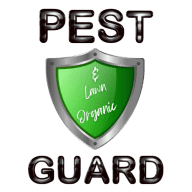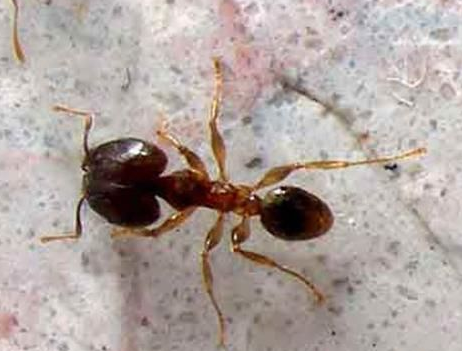Table of Contents
- 1 Schedule Your Bigheaded Ant Treatment Now!
- 2 Identifying Bigheaded Ants on Your Property
- 3 Termite Mud Tubes or Ant Trails? Here’s the Scratch Test
- 4 DIY Tips: How to Treat Bigheaded Ants Yourself
- 5 When DIY Isn’t Enough: Our Two-Step Bigheaded Ant Treatment
- 6 Bigheaded Ant Treatment Cost
- 7 Why Work with Us?
- 8 Frequently Asked Questions About Bigheaded Ants
The Bigheaded Ant – Florida’s Most Aggressive Invasive Ant
Are tiny ants turning your beautiful Florida lawn into a battlefield? You’re not alone.
Bigheaded Ant Control – Bigheaded ants (Pheidole megacephala) have exploded in numbers across Brevard County, especially in beachside and barrier island communities where warm, humid conditions and dense landscaping give them the upper hand. Once considered Florida’s #7 most problematic ant back in 1995 (according to the University of Florida), these aggressive invaders shot to the #1 ant pest in the entire state by 2007, and they’ve held onto that top spot ever since.
These ants don’t respect property lines. They form supercolonies that extend across yards, driveways, and even entire neighborhoods, making it hard for one homeowner to control the problem alone. Even if you treat your yard, it’s common for new ants to move in from next door unless the treatment is thorough and timed right.
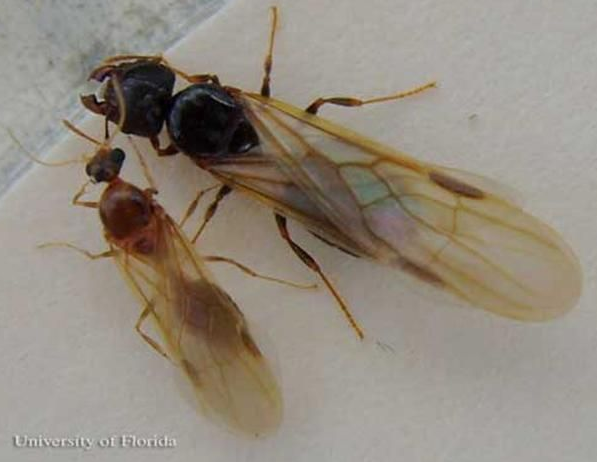
Schedule Your Bigheaded Ant Treatment Now!
What Are Bigheaded Ants?
Bigheaded ants are an invasive ant species originally from tropical Africa or Madagascar. They form massive colonies with two distinct worker types:
- Minor workers: Tiny reddish-brown ants (~2mm) that make up most of the foraging trails.
- Major workers (soldiers): Larger ants (~3-4mm) with oversized, heart-shaped heads — the source of their name.
They’re tenacious, territorial, and will outcompete both native and other invasive ants for food, space, and resources. These guys aren’t just a nuisance — they’re a takeover force.
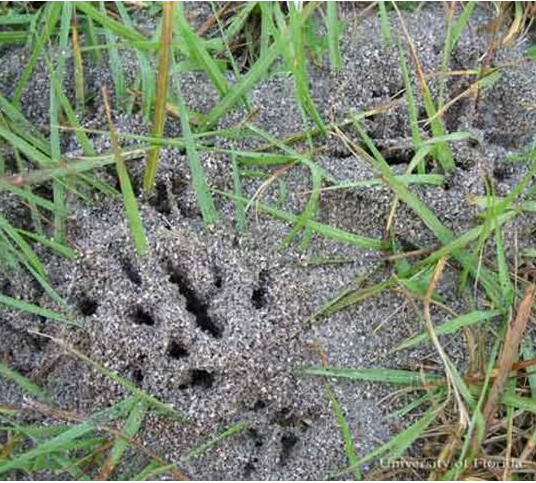
Identifying Bigheaded Ants on Your Property
Here’s what to watch for:
- Winding trails of tiny reddish-brown ants on driveways, sidewalks, irrigation boxes, trees, and your home’s foundation.
- Sandy soil piles or displaced dirt near cracks, pavers, tree roots, and lawn edges — especially around sprinkler heads and utility boxes.
- Covered trails climbing trees like cabbage palms that look like mud tubes (often mistaken for termite activity).
- Indoor ant trails, especially near sinks, pet food bowls, or bathrooms — a sign they’re expanding their search for food and water.
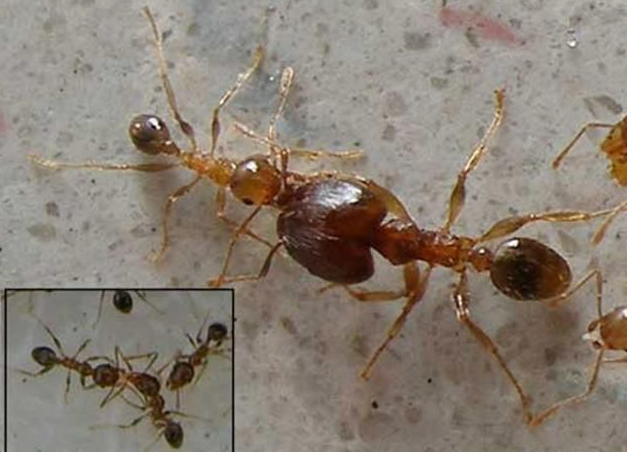
Termite Mud Tubes or Ant Trails? Here’s the Scratch Test
Bigheaded ants can build sandy soil trails that resemble termite tubes. A quick way to tell:
- Gently scratch the tube open.
- If ants come pouring out, especially reddish-brown ones, you’re dealing with bigheaded or possibly fire ants.
- If you see pale, soft-bodied insects, it’s likely subterranean termites (either Eastern Subterranean or invasive Formosan termites).
When in doubt, snap a picture or call us out — we’ll know right away.
DIY Tips: How to Treat Bigheaded Ants Yourself
If you’re a do-it-yourselfer, here are tried-and-true methods for controlling bigheaded ants — when done properly.
1. Use the Right Bait, the Right Way
Fire ant baits like Amdro Fire Ant Bait (especially the kind in the black bag with insect growth regulator) work well on bigheaded ants — but only if you get the timing and conditions right.
- Apply bait only when the ground is dry. Dew or recent rain will ruin the bait — ants won’t touch soggy pellets.
- Morning or evening is best — ants are most active then, and temperatures are milder.
- Don’t worry about light — ants don’t need daylight to find the bait.
Apply it like seasoning — a light sprinkle across the lawn and along trails, not dumped in piles.
2. Limit Overwatering — It Makes Things Worse
A lawn that’s consistently damp is a red carpet for ant colonies.
- Water only when the grass shows signs of stress (footprints that linger, slight wilting).
- Install a rain sensor on your irrigation system to avoid unnecessary watering.
- Overwatering is what we call a “pestivious” or conducive condition — it encourages ants and other insects to set up shop.
3. Eliminate Other Pests First (Especially Chinch Bugs)
Bigheaded ants love protein, and unfortunately, your lawn is probably serving up baby chinch bugs — which to an ant is like surf and turf at a steakhouse.
- When chinch bugs are present, ants have zero interest in eating bait. Why would they? The real food’s fresher and tastier.
- Think of it this way: would you eat dry cereal if lobster tails were crawling around your kitchen?
- Treating chinch bugs, aphids, and scale insects first removes their food source and makes your bait strategy work.
This is a classic pestivious condition — a pest attracting another pest.
4. Don’t Forget the Trees — Especially Palms!
Bigheaded ants will climb trees and nest in palm boots, especially when aphids or scale are present. They farm honeydew-producing insects in the canopy — a sugar source that fuels colony growth.
Depending on the situation, tree and palm spraying may be necessary to break the cycle.
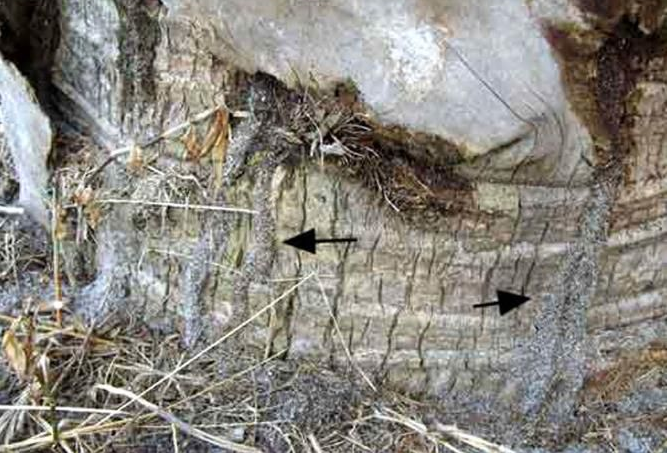
When DIY Isn’t Enough: Our Two-Step Bigheaded Ant Treatment
For stubborn infestations or when DIY fails, we offer a targeted, professional-grade treatment plan that delivers long-term results.
Step One: Granular Bait Application
- We apply a fire ant-style bait with IGR (insect growth regulator) when the lawn is dry and ants are foraging — morning or evening.
- The ants take it back to the colony, sharing it with workers and queens.
- Timing is critical — that’s why we only do this when conditions are perfect.
Step Two: Protective Barrier Treatment
- About a week later, we return to apply a liquid residual treatment around your home’s perimeter, walkways, driveways, and other hot zones.
- This forms a lasting barrier, killing ants as they cross and stopping future re-invasions.
- If applied on dry ground, we recommend a light watering afterwards to push the treatment into the soil where ants move.
Bonus: Bigheaded Ants Swarm in Spring & Summer
If you’ve noticed winged ants swarming after a good Florida rain, especially during spring or summer — those are bigheaded ant reproductives, launching new colonies.
This is when infestations spread fast, so don’t wait to act.
Bigheaded Ant Treatment Cost
Pricing: Simple and Straightforward
We charge just $0.06 per square foot of lawn space for our full two-visit service.
This includes the baiting AND the follow-up barrier treatment.
(No surprises. No upsells. Just results.)
Why Work with Us?
You don’t want to waste time with big chains or call centers. You want someone who knows Florida lawns, who shows up on time, and who cares whether the problem gets solved.
- Local owner-operator — you deal directly with me.
- Veteran-owned, so you can expect reliability and attention to detail.
- Easy scheduling online, no phone tag.
- Focused on beachside and barrier island communities like Satellite Beach, Indialantic, Melbourne Beach, and Vero.
You get the expertise of a larger company with the service and personal touch of a small one.
Ready to Reclaim Your Yard from Bigheaded Ants?
Let’s get your lawn back and protect your home.
✅ Call or text: 321-704-0434
✅ Schedule Online: Book An Appointment
✅ Serving Brevard & Indian River Counties barrier islands and beyond.
